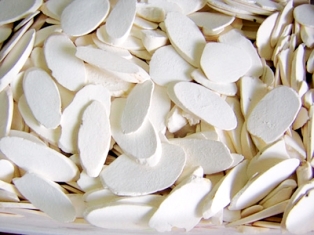News
Notice of choosing tapioca chips
Update: 8/4/2013

Tapioca chips are pan-fried slices of a particular variety of cassava root. They are a crunchy, starchy snack that can be consumed in place of tortilla chips or potato chips.
Tapioca chips can be flavored with sweet, spicy, or savory coatings, much in the same way as potato chips are often prepared. Some fried wafers made of tapioca flour are also called tapioca chips.
Tapioca chips can be flavored with sweet, spicy, or savory coatings, much in the same way as potato chips are often prepared. Some fried wafers made of tapioca flour are also called tapioca chips.
Generally, tapioca chips are made by washing, peeling, and slicing a fresh tapioca root. The slices need to be thin enough to fry into chips.
While the chips are being sliced, a generous bath of hot oil should be placed on low to medium low heat in a deep pan, pot, or dutch oven to make sure it is hot enough to fry the tapioca chips without making them soggy.
While the chips are being sliced, a generous bath of hot oil should be placed on low to medium low heat in a deep pan, pot, or dutch oven to make sure it is hot enough to fry the tapioca chips without making them soggy.
Getting the right heat levels in the oil is a vital part of achieving a well-fried tapioca chip. The best way to test the heat is often to drop in a piece of tapioca chip to see how it reacts to the hot oil. If it browns too quickly without cooking the flesh on the inside of the chip, cooks should reduce the heat.
If the oil does not bubble when the chip hits it, the heat is too low. The oil should be deep enough for the chips to float freely within it.
Once they are cooked and removed from the hot oil, chips are usually placed on a plate with a paper towel to soak up excess oil before they are served.
Once they are cooked and removed from the hot oil, chips are usually placed on a plate with a paper towel to soak up excess oil before they are served.
When making tapioca chips, it is important to get a type of cassava root called maravalli kilangu, as it is the only one that is safe to eat without being prepared in a way that removes the toxins. Most varieties of cassava root have a toxin that protects the root from invasion and damage from pests, which can also make humans sick if they eat the plant without removing the toxins.
Different varieties of cassava root have differing levels of toxins in them, and require different steps to remove enough toxin to make the root edible. Some types of cassava, like maravalli kilangu, need only be peeled and cooked to render them safe, while others must be dried, fermented, or blended and washed to remove the dangerous toxins from the plant flesh.
Different varieties of cassava root have differing levels of toxins in them, and require different steps to remove enough toxin to make the root edible. Some types of cassava, like maravalli kilangu, need only be peeled and cooked to render them safe, while others must be dried, fermented, or blended and washed to remove the dangerous toxins from the plant flesh.
Tapioca is made into a wide variety of foods, from soft savory tortillas to sweet crumbly treats. It can be served as chewy tapioca beads used in boba drinks and pudding or it may be dried, dyed, and fried for crispy snacks.
Tapioca chips are one of the few ways that cassava root is served in relatively whole form.
Tapioca chips are one of the few ways that cassava root is served in relatively whole form.
Source: http://www.wisegeek.com












